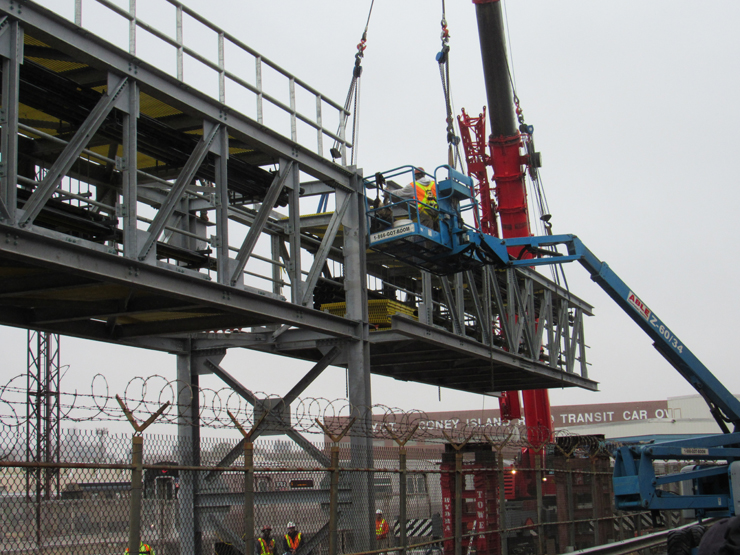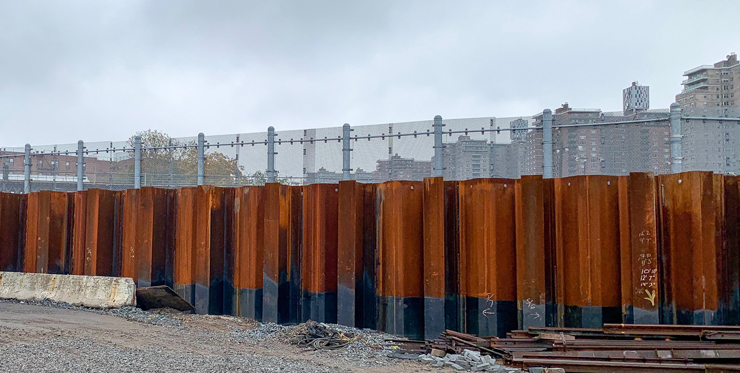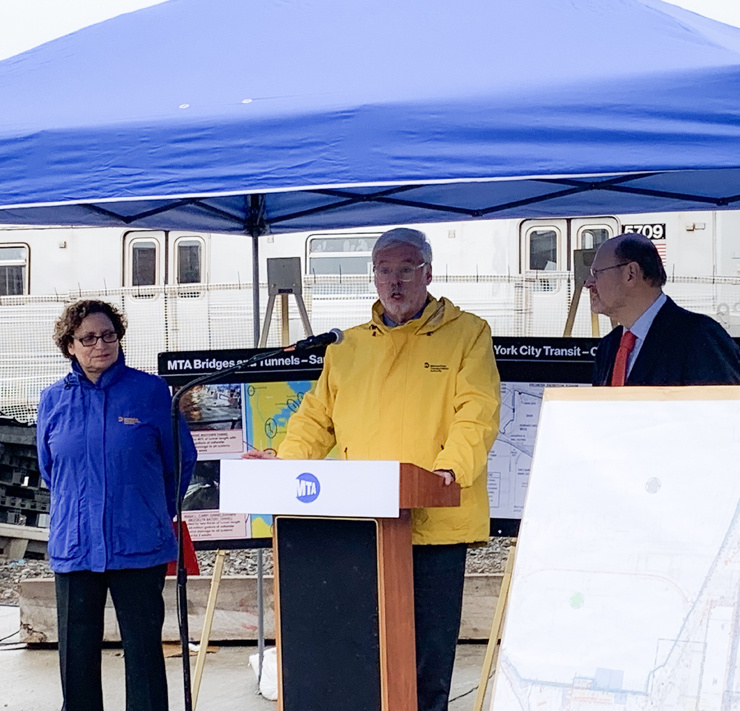CONEY ISLAND, N.Y. — Seven years after Superstorm Sandy struck the New York area, Metropolitan Transportation Authority officials on Tuesday updated restoration and remediation work for the New York transit network.
MTA Chairman and CEO Patrick Foye, Managing Director Veronica Hakim, and Joseph Lhota, MTA chairman and CEO at the time of the storm, outlined progress and future plans for subways, Metro-North, and the Long Island Rail Road at the New York City Transit Authority’s Coney Island Yard. Foye said that 77% of funding for storm-related projects has been spent, with the remainder to be voted on by the MTA board in the future.
Said Lhota, “We are prepared.”
The storm resulted in 43 deaths, 17,000 damaged home, 20,000 trees damaged or downed, and left two million people without power at some point. Some 51 square miles of land in New York City were flooded, over 15% of the total area. The resulting damage was estimated at almost $20 billion. For the MTA, service was effectively suspended for two days. In the seven years since, the MTA has made a committed effort to restore, repair, and fortify infrastructure against extreme weather.
On the subway system, the record storm surge flooded nine of 14 tubes with corrosive salt water, damaged a bridge and three yards, and inundated the key South Ferry terminal. Salt water corrosion damaged trackwork, signaling, power, and cables.
Remediation work on seven of the nine tunnels is complete. The L Train Canarsie tubes are expected to be completed by April 2020, with the Rutgers Street tubes, carrying the F train from to Manhattan from Brooklyn, scheduled for rehabilitation soon.
The MTA has also installed flood mitigation equipment in subway stations and under-river tunnels, waterproofing some facilities and rebuilding others at higher ground. It has raised critical power and communications equipment above flood levels and installed protective equipment at 79 station entrances. Approximately 3,500 points of water entry for the subway system have received flood protection devices, including 24 3,000-pound submarine-style doors; 2,300 waterproof gates deployed underneath sidewalk grates for station vents; 1,700 portable vent covers; and 68 flexible stairwell covers that can withstand up to 14 feet of water.
Of all the projects, one of the most significant is the ongoing resiliency work at the large Coney Island Yard Complex, a 74-acre facility capable of housing 881 railcars, which was extensively damaged by 27 million gallons of floodwater and debris. At the height of the storm, the yard was covered by more than a foot of water.
The estimated 54-month project began in March 2018. It will include a new 4,280-foot-long bridge to carry electrical cables for third-rail power overhead, rather than underground, as was previously the case. In addition to offering better protection from flooding, this will make the cables easier to maintain. The project will also include 12,000 linear feet of a flood wall, 8- to 14-feet high and driven 30 feet below ground; 21,000 linear feet of new drainage; nine flood gates; two new pump stations, and hardening of the Traction Power Motor Shop.
The storm submerged the Long Island Rail Road tubes linking Manhattan with Queens, and caused operational problems with downed trees and poles along hundreds of miles of right-of-way. Tracks, passenger equipment, switches, crossings, overhead wires, and yards all sustained damage.
Since then, three LIRR electrical substations on the Long Beach Branch were replaced to meet new flood protection standards and one in Manhattan was upgraded; those projects are complete. Still to be completed are a flood wall around the perimeter of the LIRR’s Long Island City Yard, and replacement of switch machines, switch heaters, signal components, third-rail components, and fire-alarm systems at the West Side Yard near Penn Station.
On Metro-North, damaged substations in Riverdale, Tarrytown, and Croton-Harmon have been replaced on higher ground; their final testing is anticipated to begin late this year. Power equipment that operates mechanism for the Harlem River Lift Bridge hwas rebuilt at a higher level and equipped with watertight doors and sump pumps with new power cables. All affected rights-of-way have also been restored and 11 locomotive-hauled coaches have been rehabilitated.

















NY MTA repairs significantly did not include the East River tunnels carrying the LIRR (and AMTRAK) into Manhattan. The funds allocated are currently in dispute, with the MTA/LIRR having used most of the federal Sandy relief funds for projects such as those noted in the article. The tunnels are AMTRAK’s responsibility, with the MTA/LIRR typically paying roughly 1/4 of the costs. NY Sen Schumer wants the funds used to fix the tunnels, but reportedly little remains. MTA/LIRR wants federal funding through AMTRAK, which reportedly is not available for this purpose. While the parties disagree, the corrosion caused by salt water intrusion continues to get worse. Penn Station serves 650,000 passengers daily. A significant portion of them ride the LIRR, and the rest are served by AMTRAK and NJ Transit. AMTRAK also needs the tunnels to stage trains from Sunnyside Yards, as does NJ Transit. AMTRAK also uses them for through service to New England, including Acela service. Losing the tunnels would be a devastating blow to the NY (and NJ) economy, especially Long Island. Subway and roads are already over-taxed. Stay tuned!
Sounds like a lot of poor planning on the locals part should have been a ticket surcharge fund decades ago for repair/replacement projects rather than expecting federal taxpayer dollars to make up for it, as the old saying goes… Poor planning on others part does not constitute an emergency on my part.